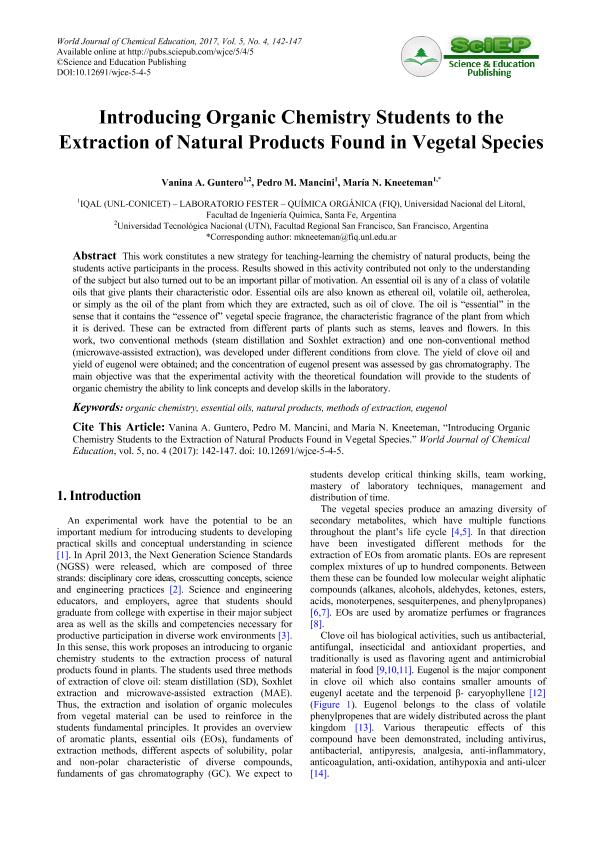Mostrar el registro sencillo del ítem
dc.contributor.author
Guntero, Vanina Alejandra

dc.contributor.author
Mancini, Pedro Maximo Emilio

dc.contributor.author
Kneeteman, Maria Nelida

dc.date.available
2019-11-18T21:41:10Z
dc.date.issued
2017-08
dc.identifier.citation
Guntero, Vanina Alejandra; Mancini, Pedro Maximo Emilio; Kneeteman, Maria Nelida; Introducing Organic Chemistry Students to the Extraction of Natural Products Found in Vegetal Species; Science and Education publishing; World Journal of Chemical Education; 5; 4; 8-2017; 142-147
dc.identifier.issn
2375-1665
dc.identifier.uri
http://hdl.handle.net/11336/89166
dc.description.abstract
This work constitutes a new strategy for teaching-learning the chemistry of natural products, being the students active participants in the process. Results showed in this activity contributed not only to the understanding of the subject but also turned out to be an important pillar of motivation. An essential oil is any of a class of volatile oils that give plants their characteristic odor. Essential oils are also known as ethereal oil, volatile oil, aetherolea, or simply as the oil of the plant from which they are extracted, such as oil of clove. The oil is ?essential? in the sense that it contains the ?essence of? vegetal specie fragrance, the characteristic fragrance of the plant from which it is derived. These can be extracted from different parts of plants such as stems, leaves and flowers. In this work, two conventional methods (steam distillation and Soxhlet extraction) and one non-conventional method (microwave-assisted extraction), was developed under different conditions from clove. The yield of clove oil and yield of eugenol were obtained; and the concentration of eugenol present was assessed by gas chromatography. The main objective was that the experimental activity with the theoretical foundation will provide to the students of organic chemistry the ability to link concepts and develop skills in the laboratory.
dc.format
application/pdf
dc.language.iso
eng
dc.publisher
Science and Education publishing
dc.rights
info:eu-repo/semantics/openAccess
dc.rights.uri
https://creativecommons.org/licenses/by-nc-sa/2.5/ar/
dc.subject
Organic Chemistry
dc.subject
Essential Oils
dc.subject
Methods of Extraction
dc.subject
Natural Products
dc.subject
Eugenol
dc.subject.classification
Otras Ciencias Químicas

dc.subject.classification
Ciencias Químicas

dc.subject.classification
CIENCIAS NATURALES Y EXACTAS

dc.title
Introducing Organic Chemistry Students to the Extraction of Natural Products Found in Vegetal Species
dc.type
info:eu-repo/semantics/article
dc.type
info:ar-repo/semantics/artículo
dc.type
info:eu-repo/semantics/publishedVersion
dc.date.updated
2018-01-02T14:02:28Z
dc.identifier.eissn
2375-1657
dc.journal.volume
5
dc.journal.number
4
dc.journal.pagination
142-147
dc.journal.pais
India

dc.description.fil
Fil: Guntero, Vanina Alejandra. Universidad Nacional del Litoral. Facultad de Ingeniería Química. Departamento de Química Orgánica; Argentina. Universidad Tecnológica Nacional; Argentina. Consejo Nacional de Investigaciones Científicas y Técnicas. Centro Científico Tecnológico Conicet - Santa Fe; Argentina
dc.description.fil
Fil: Mancini, Pedro Maximo Emilio. Universidad Nacional del Litoral. Facultad de Ingeniería Química. Departamento de Química Orgánica; Argentina. Consejo Nacional de Investigaciones Científicas y Técnicas. Centro Científico Tecnológico Conicet - Santa Fe; Argentina
dc.description.fil
Fil: Kneeteman, Maria Nelida. Universidad Nacional del Litoral. Facultad de Ingeniería Química. Departamento de Química Orgánica; Argentina. Consejo Nacional de Investigaciones Científicas y Técnicas. Centro Científico Tecnológico Conicet - Santa Fe; Argentina
dc.journal.title
World Journal of Chemical Education
dc.relation.alternativeid
info:eu-repo/semantics/altIdentifier/doi/http://dx.doi.org/10.12691/wjce-5-4-5
Archivos asociados
